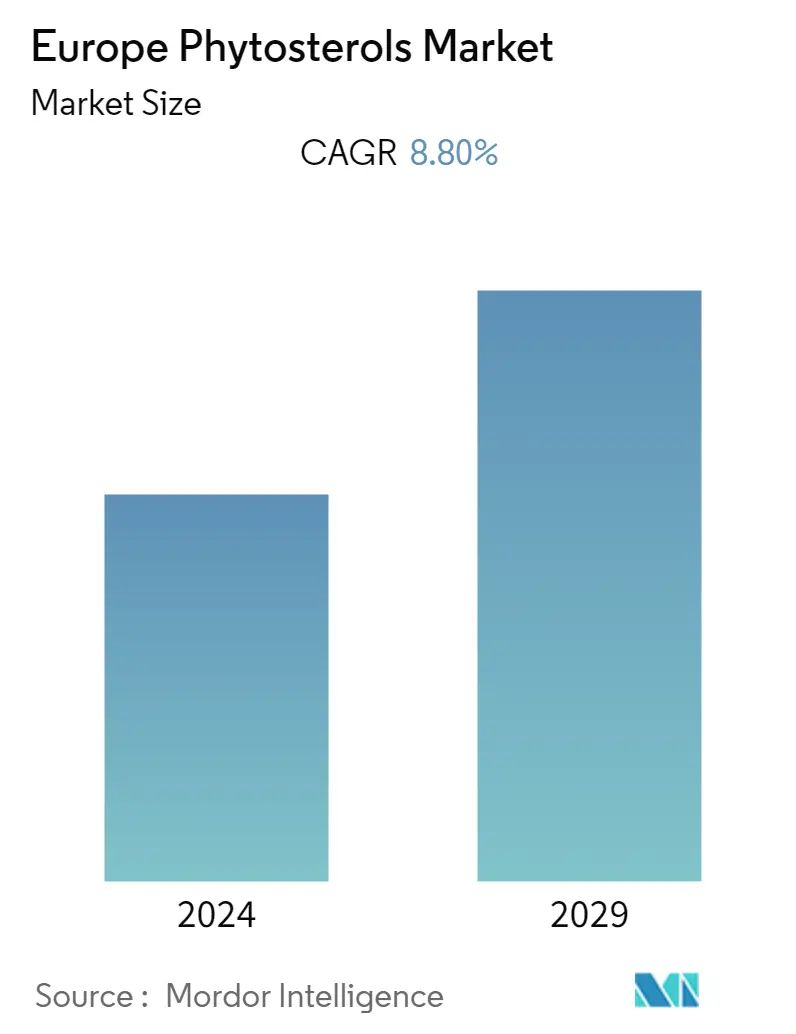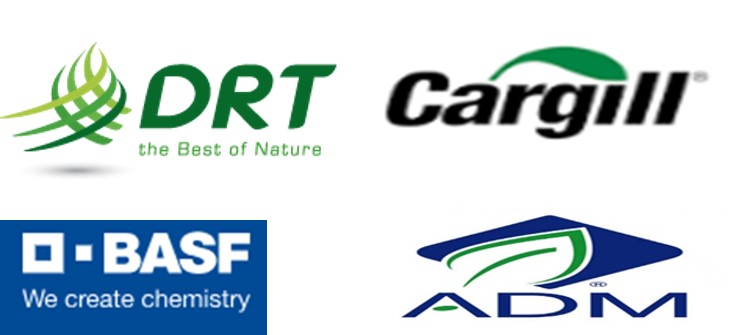Market Size of Europe Phytosterols Industry

| Study Period | 2019 - 2029 |
| Base Year For Estimation | 2023 |
| Forecast Data Period | 2024 - 2029 |
| Historical Data Period | 2019 - 2022 |
| CAGR | 8.80 % |
| Market Concentration | Low |
Major Players
*Disclaimer: Major Players sorted in no particular order |
Europe Phytosterol Market Analysis
Europe phytosterol market forecasted to reach USD 540.81 million by 2025growing at a CAGR of 8.8% during the forecast period.
- Europe holds a prominent share in phytosterol market which is strongly led by countries, such as Germany, the United Kingdom, Spain, and Italy. According to the European Food Safety Authority (EFSA), consumption of 1.5 g- 2.4 g of plant sterols per day helps to reduce the blood cholesterol levels by 7%-10%.
- This, in turn, has increased the application of phytosterols in pharmaceutical industries holding dominance in dietary supplements. The increasing demand for non-GMO products is also augmenting the growth of phytosterol in the region. In order to meet the rising demand for phytosterols and to optimize its sterols production infrastructure, companies such as BASF increased its sterol extraction capacity at its site in Boussens, France.
Europe Phytosterol Industry Segmentation
The type of phytsterols present in the European market namely, beta-setosterol, campesterol, stigmasterol, and other types are driven from two primary sources which includes wood sterol and vegetable oil sterols. The sterols present in the market hold applications in differed food and beverage industries which includes, dairy products, sauces and condiments, beverages bakery and confectionery and other processed foods. The sterols also hold the application in pharmaceutical industries such as cosmetics, dietary supplements, and animal feed.
| By Product Type | |
| Beta-Sitosterol | |
| Campesterol | |
| Stigmasterol | |
| Other Product Types |
| By Application | ||||||
| ||||||
| Pharmaceuticals | ||||||
| Cosmetics | ||||||
| Dietary Supplements | ||||||
| Animal Feed |
| Geography | |
| Spain | |
| United Kingdom | |
| Germany | |
| France | |
| Italy | |
| Russia | |
| Rest of Europe |
Europe Phytosterols Market Size Summary
The Europe phytosterol market is experiencing significant growth, driven by the increasing demand for cholesterol-lowering products and the rising awareness of cardiovascular health. Countries like Germany, the United Kingdom, Spain, and Italy are leading the market, with phytosterols being widely used in pharmaceutical applications to combat cardiovascular diseases and other health issues. The European Food Safety Authority's endorsement of plant sterols for cholesterol reduction has further propelled their use in dietary supplements. The demand for non-GMO products is also contributing to market expansion, prompting companies such as BASF to enhance their production capabilities in the region. The food and beverage industry holds the largest market share, with products like spreads and yogurt drinks infused with phytosterols gaining popularity, particularly in Finland, the Netherlands, Belgium, Germany, and the United Kingdom.
The competitive landscape of the Europe phytosterol market is characterized by key players such as Arboris, Archer Daniels Midland, BASF, and Cargill, who are focusing on new product launches, expansions, and strategic partnerships to maintain their market positions. These companies are leveraging tall and vegetable oils for phytosterol extraction, which is being incorporated into various food products, including reduced-fat cheese. The rising demand for nutritional drinks is expected to further boost the market, as manufacturers continue to innovate and introduce new products with added health benefits. The European Union's regulations mandating the labeling of phytosterol content in products also support market growth by ensuring transparency and encouraging consumer trust.
Europe Phytosterols Market Size - Table of Contents
-
1. MARKET DYNAMICS
-
1.1 Market Drivers
-
1.2 Market Restraints
-
1.3 Porters Five Forces Analysis
-
1.3.1 Threat of New Entrants
-
1.3.2 Bargaining Power of Buyers/Consumers
-
1.3.3 Bargaining Power of Suppliers
-
1.3.4 Threat of Substitute Products
-
1.3.5 Intensity of Competitive Rivalry
-
-
-
2. MARKET SEGMENTATION
-
2.1 By Product Type
-
2.1.1 Beta-Sitosterol
-
2.1.2 Campesterol
-
2.1.3 Stigmasterol
-
2.1.4 Other Product Types
-
-
2.2 By Application
-
2.2.1 Food and Beverage
-
2.2.1.1 Dairy Products
-
2.2.1.2 Sauces and Condiments
-
2.2.1.3 Beverages
-
2.2.1.4 Bakery and Confectionery
-
-
2.2.2 Pharmaceuticals
-
2.2.3 Cosmetics
-
2.2.4 Dietary Supplements
-
2.2.5 Animal Feed
-
-
2.3 Geography
-
2.3.1 Spain
-
2.3.2 United Kingdom
-
2.3.3 Germany
-
2.3.4 France
-
2.3.5 Italy
-
2.3.6 Russia
-
2.3.7 Rest of Europe
-
-
Europe Phytosterols Market Size FAQs
What is the current Europe Phytosterols Market size?
The Europe Phytosterols Market is projected to register a CAGR of 8.80% during the forecast period (2024-2029)
Who are the key players in Europe Phytosterols Market?
Berkshire Hathaway Inc., Archer Daniels Midland Company, Cargill, Incorporated and Gustav Parmentier GmBH are the major companies operating in the Europe Phytosterols Market.

